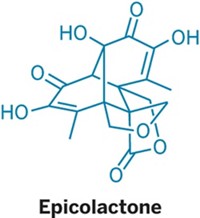Advertisement
Grab your lab coat. Let's get started
Welcome!
Welcome!
Create an account below to get 6 C&EN articles per month, receive newsletters and more - all free.
It seems this is your first time logging in online. Please enter the following information to continue.
As an ACS member you automatically get access to this site. All we need is few more details to create your reading experience.
Not you? Sign in with a different account.
Not you? Sign in with a different account.
ERROR 1
ERROR 1
ERROR 2
ERROR 2
ERROR 2
ERROR 2
ERROR 2
Password and Confirm password must match.
If you have an ACS member number, please enter it here so we can link this account to your membership. (optional)
ERROR 2
ACS values your privacy. By submitting your information, you are gaining access to C&EN and subscribing to our weekly newsletter. We use the information you provide to make your reading experience better, and we will never sell your data to third party members.
Synthesis
Making A Toxin
Researchers build a poisonous lipid found in mussels
by Sarah Everts
January 29, 2009

A quirky lipid that is associated with seafood toxicity has been constructed in a lab for the first time. The work opens the possibility of developing tools to detect and study the molecule.
First isolated from mussels in the Adriatic Sea, the compound is "a chemical oddity" because it's a lipid that features both a sulfate group and six chlorine atoms, which is unusual, says Erick M. Carreira, a chemist at the Swiss Federal Institute of Technology, Zurich, who led the research. He and coworkers report the synthesis in Nature (2009, 457, 573).
The toxin probably originates from algae that is consumed by the mussel, explains Ernesto Fattorusso, a pharmacologist at the University of Naples Federico II who isolated the chlorosulfolipid in 1999. "But we were only able to extract a few milligrams," Fattorusso says. "This synthesis appears relatively simple, considering the stereochemical complexity of the molecule," so there are hopes of obtaining enough of it for extensive biological studies.
Researchers are uncertain whether this compound is a direct toxic agent in cases of seafood poisoning. The synthesis could help them make this determination.
Moreover, the synthesis will allow investigators to examine other biological roles of chlorosulfolipids, such as being a component of algae cell membranes, writes Christopher D. Vanderwal of the University of California, Irvine, in an associated Nature commentary. "I'm interested in finding out why nature would put chlorines in a lipid at all," Carreira says.
Vanderwal also notes that the 10-step synthetic strategy that produced the unusual lipids is "simple and direct, but seems to be the result of painstaking experimentation."
"There were a lot of dead ends," Carreira says. But students Christian Nilewski and Roger W. Geisser reached their synthetic goal by employing alkene dichlorination reactions and an epoxide ring-opening sequence.
The ring-opening step led to a "chemical surprise," Carreira notes. Normally, epoxides undergo ring opening with an inversion of configuration at the carbon that is being attacked, but here the team observed a retention of configuration. It turns out that the chloride-induced epoxide opening proceeds by double inversion, Carreira explains. He and his coworkers also propose that an unusual four- or five-membered chloronium ring intermediate is formed during the process. "There are many interesting mechanistic curiosities to be explored in this system," he adds.
Because the synthesis is not enantioselective, Carreira says that he and his colleagues will next work to develop an enantioselective version of the procedure, as well as syntheses of other chlorosulfolipids.





Join the conversation
Contact the reporter
Submit a Letter to the Editor for publication
Engage with us on Twitter